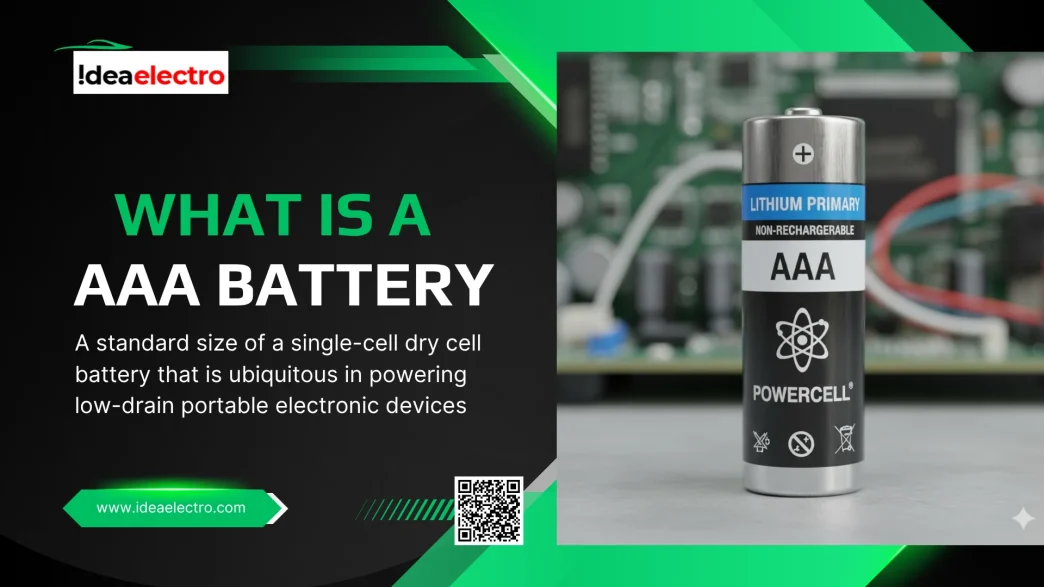An AAA battery, also known as a triple-A battery, is a standard size of a single-cell dry cell battery that is ubiquitous in powering low-drain portable electronic devices. These batteries serve the basic purpose of providing a portable, self-contained power source, with a typical nominal voltage of 1.5 volts for disposable varieties and 1.2 volts for common rechargeable types like Nickel-Metal Hydride (NiMH). Their compact energy makes them an ideal choice for a vast array of everyday electronics. As of 2007, they accounted for 24% of alkaline primary battery sales in the United States, underscoring their widespread adoption. You will most commonly find them inside devices like TV remote controls, MP3 players, wireless mice, and digital cameras, where their balance of size and power output is perfectly suited.
Physical Size & Design Specifications

The physical design of the AAA battery is defined by international standards, ensuring compatibility across devices and manufacturers from around the world. It is a cylindrical cell that measures 44.5 millimeters (1.75 inches) in length and 10.5 millimeters (0.41 inches) in diameter. This specific size is critical for it to fit correctly into battery compartments designed for its form factor. The positive terminal is a button that has a minimum height of 0.8 millimeters, while the flat negative terminal has a larger minimum diameter to help ensure proper polarity alignment. The weight of a AAA battery is not a fixed value and varies depending on its chemical composition; for instance, an alkaline AAA battery weighs around 11.5 grams, whereas a primary lithium version is lighter at approximately 7.6 grams. These batteries are known by various codes from different standardization bodies, which are used to identify them across technical datasheets and commercial packaging.
| Specification | Value |
| Length | 44.5 mm |
| Diameter | 10.5 mm |
| Nominal Voltage | 1.5V (disposable), 1.2V (NiMH), 3.7V (Li-ion) |
| Typical Weight | ~11.5 g (Alkaline), ~7.6 g (Lithium primary) |
| IEC Code | R03 (Zinc-Carbon), LR03 (Alkaline), HR03 (NiMH) |
| ANSI/NEDA Code | 24D (Zinc-Carbon), 24A (Alkaline), 24H (NiMH) |
Types of AAA Batteries

- Alkaline
These are the most common and widely available type of AAA battery. They are single-use (non-rechargeable) and offer a good balance of capacity, shelf life, and cost. They are suitable for a wide range of low to moderate-drain devices like remote controls, clocks, toys, and flashlights.
- Nickel-Metal Hydride (NiMH)
NiMH batteries are the most common type of rechargeable AAA battery. They can be recharged hundreds of times, making them cost-effective and eco-friendly for high-drain devices. They are ideal for items like digital cameras, gaming controllers, and high-performance flashlights, though they tend to lose their charge slowly when not in use (self-discharge).
- Nickel-Cadmium (NiCd)
An older type of rechargeable battery, NiCd is less common today due to its lower capacity and the toxic cadmium content. Their main advantage is that they can deliver very high surge currents and are less affected by cold temperatures, but they suffer from a “memory effect” which can reduce their usable capacity if not fully discharged before recharging.
- Lithium (Primary – Non-rechargeable)
These are premium, single-use batteries known for their very long shelf life (up to 10-20 years) and excellent performance in extreme temperatures, both hot and cold. They are also very lightweight and have a higher voltage for a longer portion of their life, making them perfect for critical applications like emergency gear, outdoor equipment, and high-end electronics.
- Lithium-Ion (Li-ion – Rechargeable)
These rechargeable AAA batteries have a higher nominal voltage (3.7V) than standard batteries (1.5V), so they often require a special charger and are typically used in devices designed for them, like certain vape pens, high-end tech, or power tools. Standard Li-ion AAA cells usually have a built-in USB port for convenient recharging.
- Carbon-Zinc (Heavy-Duty or General Purpose)
This is an older, less powerful, and inexpensive technology. They have a very low capacity and are not suitable for anything more than very low-drain devices like a wall clock or a TV remote. Their performance drops significantly in cold weather, and they are generally considered a budget, low-performance option.
- Low Self-Discharge NiMH (LSD NiMH)
This is a sub-category of NiMH batteries that are designed to hold their charge for much longer when not in use. Pre-charged and ready to go, they can retain most of their power for a year or more. Brands like Eneloop are famous for this type, making them extremely convenient for devices that are used occasionally.

How AAA Batteries Work
At its core, a AAA battery operates by converting stored chemical energy into electrical energy through a controlled electrochemical reaction. Inside the battery cell, two electrodes—a positive cathode and a negative anode—are separated by an electrolyte substance that allows ions to flow while forcing electrons to travel through an external circuit, thus creating an electric current that powers the device. In a disposable alkaline battery, the reaction involves zinc oxidizing at the anode and manganese dioxide reducing at the cathode within an alkaline electrolyte. This reaction is irreversible; once the reactants are depleted, the battery is dead. In rechargeable variants, such as Nickel-Metal Hydride (NiMH) or Lithium-ion, the chemical reactions are reversible. When an external electrical current is applied from a charger, the reaction is driven in reverse, restoring the components to their high-energy state and allowing the battery to be used repeatedly over many charge cycles.
Common Uses & Applications
The small size and sufficient power output of AAA batteries make them the preferred energy source for a multitude of portable and compact electronic devices. Common household and personal applications include:
- TV remote controls, MP3 players, and digital audio players.
- Wireless computer peripherals, such as mice and keyboards.
- Digital cameras and flash units.
- Cordless phones, handheld gaming controllers, and small flashlights.
- Clocks, calculators, and digital thermometers.
- Children’s toys, smoke detectors, and various medical devices like thermometers.
AAA vs AA Batteries
The most apparent difference between AAA and AA batteries is their physical size, which directly influences their energy capacity and, consequently, their typical applications. The AAA battery is significantly smaller, measuring 44.5 mm in length and 10.5 mm in diameter, whereas the AA battery is larger at 50.5 mm in length and 14.5 mm in diameter. This larger volume allows the AA battery to hold more active material, giving it a much higher capacity—generally 2000-3000 mAh for AA compared to 600-1200 mAh for AAA in alkaline forms. Consequently, AA batteries are better suited for power-hungry, high-drain devices like digital cameras, powerful flashlights, and portable radios, as their higher capacity provides longer runtimes. In contrast, AAA batteries are engineered for compact, low-drain devices where saving space and weight is a priority, such as in remote controls or wireless peripherals. It is crucial to note that these two battery sizes are not directly interchangeable due to their physical dimensions; using a AAA battery in a device designed for AA will break the electrical circuit unless an external adapter is used.
| Feature | AAA Battery | AA Battery |
| Length | 44.5 mm | 50.5 mm |
| Diameter | 10.5 mm | 14.5 mm |
| Typical Capacity (Alkaline) | 600 – 1200 mAh | 1400 – 3500 mAh |
| Common Applications | Remote controls, wireless mice | Digital cameras, portable speakers |
Advantages & Limitations of AAA Batteries
AAA batteries offer a unique set of benefits that secure their place in the electronics ecosystem, alongside some inherent limitations dictated by their small form factor.
- Advantages:
- Compact and Lightweight: Their small size makes them ideal for sleek and portable device designs without adding significant bulk or weight.
- Wide Availability: As one of the most common battery sizes, they are readily available in stores worldwide.
- Versatility: They are produced in a range of chemistries, allowing users to select a type that best matches their device’s power requirements and their budget.
- Limitations:
- Lower Energy Capacity: The principal trade-off for their small size is a lower mAh rating compared to larger batteries like the AA, resulting in shorter runtimes in comparable applications.
- Not Suited for High-Drain Devices: They may deplete very quickly when used in devices that draw a large amount of current, making them an impractical choice for such equipment.
- Frequent Replacement: In frequently used devices, single-use AAA batteries may need to be replaced often, which can become costly and generate more waste over time.
Despite these limitations, AAA batteries remain widely used because their advantages perfectly align with the needs of modern compact electronics. The ongoing improvement of rechargeable NiMH technology, which offers high capacity and hundreds of recharge cycles, effectively mitigates the limitation of limited capacity for many users, ensuring the AAA battery’s continued relevance.
Safety, Handling & Disposal Tips
Proper care and disposal of AAA batteries are essential for both personal safety and environmental protection. Adhering to a few key guidelines can prevent accidents and minimize ecological impact:
- Storage: Keep batteries in a cool, dry place at room temperature. Do not refrigerate them.
- Device Use: Always insert batteries with the correct polarity (+/-) aligned. Remove batteries from devices that will not be used for several months to prevent potential leakage and damage.
- Pre-Disposal Preparation: For safe recycling, particularly of rechargeable batteries, place non-conductive tape (e.g., electrical tape) over the terminals to prevent short-circuiting.
- Disposal: Never dispose of rechargeable batteries in household trash. Single-use alkaline batteries can often be thrown away, but recycling is strongly encouraged. Utilize designated battery recyclers, drop-off locations at retailers, or household hazardous waste collection programs.









